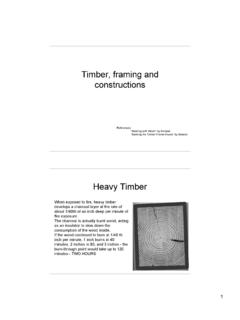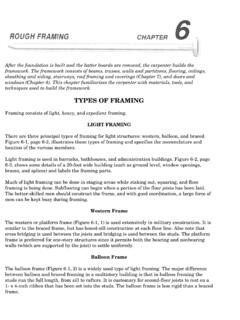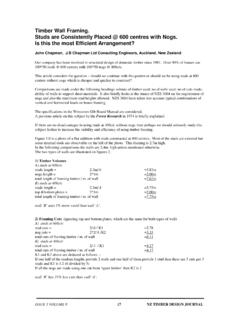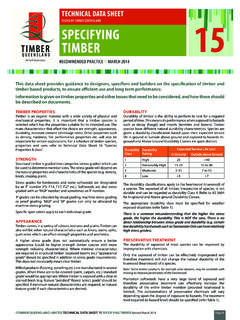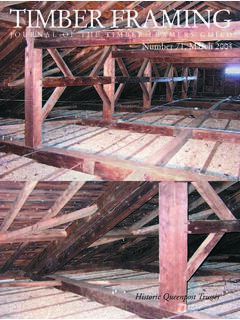Transcription of AS 1684.2-2010 Residential timber-framed construction ...
1 ASAS 2010 Residential timber -framed constructionPart 2: Non-Cyclonic AreasAccessed by QUEENSLAND UNIVERSITY OF TECHNOLOGY on 23 Aug 2011 This Australian Standard was prepared by Committee TM-002, timber Framing. It was approved on behalf of the Council of Standards Australia on 21 December 2009. This Standard was published on 21 June 2010. The following are represented on Committee TM-002: A3P Association of Consulting Engineers, Australia Australian Building Codes Board Australian Institute of Building Building Research Association of New Zealand CSIRO Manufacturing and Infrastructures Technology Engineered Wood Products Association of Australasia Engineers Australia Forest Industries Federation (WA) Frame and Truss Manufacturers Association Australia Housing Industry Association Master Builders, Australia New Zealand timber Industry Federation Scion South Australian Housing Trust timber and Building Materials Association, NSW timber Development Association, NSW timber Queensland Additional Interests.
2 Mr Peter Juniper This Standard was issued in draft form for comment as DR AS Standards Australia wishes to acknowledge the participation of the expert individuals that contributed to the development of this Standard through their representation on the Committee and through the public comment period. Keeping Standards up-to-date Australian Standards are living documents that reflect progress in science, technology and systems. To maintain their currency, all Standards are periodically reviewed, and new editions are published. Between editions, amendments may be issued. Standards may also be withdrawn. It is important that readers assure themselves they are using a current Standard, which should include any amendments that may have been published since the Standard was published. Detailed information about Australian Standards, drafts, amendments and new projects can be found by visiting Standards Australia welcomes suggestions for improvements, and encourages readers to notify us immediately of any apparent inaccuracies or ambiguities.
3 Contact us via email at or write to Standards Australia, GPO Box 476, Sydney, NSW 2001. Accessed by QUEENSLAND UNIVERSITY OF TECHNOLOGY on 23 Aug 2011 AS 2010 Australian Standard Residential timber -framed construction Part 2: Non-cyclonic areas First published as AS O56 1946. Second edition 1948. Revised and redesignated as AS CA38 1971. Revised and redesignated as AS 1684 1975. Third edition 1992. Revised and redesignated in part as AS 1999. Third edition 2010. COPYRIGHT Standards Australia All rights are reserved. No part of this work may be reproduced or copied in any form or by any means, electronic or mechanical, including photocopying, without the written permission of the publisher. Published by Standards Australia GPO Box 476, Sydney, NSW 2001, Australia ISBN 978 0 7337 9433 9 Accessed by QUEENSLAND UNIVERSITY OF TECHNOLOGY on 23 Aug 2011AS 2010 2 PREFACE This Standard was prepared by the Joint Standards Australian/Standards New Zealand Committee TM-002, timber Framing, to supersede AS 2006.
4 After consultation with stakeholders in both countries, Standards Australia and Standards New Zealand decided to develop this Standard as an Australian Standard rather than an Australian/New Zealand Standard. The objective of this Standard is to provide the building industry with procedures that can be used to determine building practice, to design or check construction details, and to determine member sizes, and bracing and fixing requirements for timber -framed construction in non-cyclonic areas. The objectives of this revision are to (a) include editorial amendments and some technical changes to correct mistakes, clarify interpretation and enhance the application of the document; (b) incorporate the outcomes of recent research projects that considered the role and function of wall noggings (Clause ) and alternative simplified tie-down systems for higher wind areas in particular using ring beam construction methods; (c) include information on generic building practices for EWPs (engineered wood products), which are being widely used in timber -framed construction (see Appendix J).
5 And (d) provide some adjustments to the span table values in the Supplements for stress grades MGP 10, MGP 12 and MGP 15 in response to changes to the design characteristic values for these stress grades in AS NOTE: These adjustments have been made recognizing that MGP stress grades represent the major product usage in the marketplace. Further work is required to assess and more fully respond to existing and expected changes to the related loading, design, and design criteria Standards, and this may result in a future revision of Span Tables in the Supplements for all stress grades. This Standard is a companion publication to the following: AS 1684 Residential timber -framed construction Part 1: Design criteria Part 3: Cyclonic areas Part 4: Simplified Non-cyclonic areas This Standard provides detailed design, bracing and connection procedures for wind classifications N1 to N4.
6 Prior to using this Standard, it is necessary to establish the design gust wind speed and wind classification (see Clause ). Alternatively, for wind classifications N1 and N2, AS provides a simpler set of design solutions derived from this Standard. It should be noted that a more economical design may be obtained by following the design procedures given in this Standard. It should also be noted that AS includes additional differences to AS and Accessed by QUEENSLAND UNIVERSITY OF TECHNOLOGY on 23 Aug 2011 3 AS 2010 The following Supplements form an integral part of, and must be used in conjunction with, this Standard: Supplement 0 General introduction and index N1/N2 Supp. 1 Wind classification N1/N2 Seasoned softwood Stress grade F5 N1/N2 Supp. 2 Wind classification N1/N2 Seasoned softwood Stress grade F7 N1/N2 Supp.
7 3 Wind classification N1/N2 Seasoned softwood Stress grade F8 N1/N2 Supp. 4 Wind classification N1/N2 Seasoned softwood Stress grade MGP 10 N1/N2 Supp. 5 Wind classification N1/N2 Seasoned softwood Stress grade MGP 12 N1/N2 Supp. 6 Wind classification N1/N2 Seasoned softwood Stress grade MGP 15 N1/N2 Supp. 7 Wind classification N1/N2 WA seasoned hardwood Stress grade F14 N1/N2 Supp. 8 Wind classification N1/N2 Seasoned hardwood Stress grade F17 N1/N2 Supp. 9 Wind classification N1/N2 Seasoned hardwood Stress grade F27 N1/N2 Supp. 10 Wind classification N1/N2 Unseasoned softwood Stress grade F5 N1/N2 Supp. 11 Wind classification N1/N2 Unseasoned softwood Stress grade F7 N1/N2 Supp. 12 Wind classification N1/N2 Unseasoned hardwood Stress grade F8 N1/N2 Supp. 13 Wind classification N1/N2 Unseasoned hardwood Stress grade F11 N1/N2 Supp.
8 14 Wind classification N1/N2 Unseasoned hardwood Stress grade F14 N1/N2 Supp. 15 Wind classification N1/N2 Unseasoned hardwood Stress grade F17 N3 Supp. 1 Wind classification N3 Seasoned softwood Stress grade F5 N3 Supp. 2 Wind classification N3 Seasoned softwood Stress grade F7 N3 Supp. 3 Wind classification N3 Seasoned softwood Stress grade F8 N3 Supp. 4 Wind classification N3 Seasoned softwood Stress grade MGP 10 N3 Supp. 5 Wind classification N3 Seasoned softwood Stress grade MGP 12 N3 Supp. 6 Wind classification N3 Seasoned softwood Stress grade MGP 15 N3 Supp. 7 Wind classification N3 WA seasoned hardwood Stress grade F14 N3 Supp. 8 Wind classification N3 Seasoned hardwood Stress grade F17 N3 Supp. 9 Wind classification N3 Seasoned hardwood Stress grade F27 N3 Supp. 10 Wind classification N3 Unseasoned softwood Stress grade F5 N3 Supp.
9 11 Wind classification N3 Unseasoned softwood Stress grade F7 N3 Supp. 12 Wind classification N3 Unseasoned hardwood Stress grade F8 N3 Supp. 13 Wind classification N3 Unseasoned hardwood Stress grade F11 N3 Supp. 14 Wind classification N3 Unseasoned hardwood Stress grade F14 N3 Supp. 15 Wind classification N3 Unseasoned hardwood Stress grade F17 N4 Supp. 1 Wind classification N4 Seasoned softwood Stress grade F5 N4 Supp. 2 Wind classification N4 Seasoned softwood Stress grade F7 N4 Supp. 3 Wind classification N4 Seasoned softwood Stress grade F8 N4 Supp. 4 Wind classification N4 Seasoned softwood Stress grade MGP 10 N4 Supp. 5 Wind classification N4 Seasoned softwood Stress grade MGP 12 N4 Supp. 6 Wind classification N4 Seasoned softwood Stress grade MGP 15 N4 Supp. 7 Wind classification N4 WA seasoned hardwood Stress grade F14 N4 Supp.
10 8 Wind classification N4 Seasoned hardwood Stress grade F17 N4 Supp. 9 Wind classification N4 Seasoned hardwood Stress grade F27 N4 Supp. 10 Wind classification N4 Unseasoned softwood Stress grade F5 N4 Supp. 11 Wind classification N4 Unseasoned softwood Stress grade F7 N4 Supp. 12 Wind classification N4 Unseasoned hardwood Stress grade F8 N4 Supp. 13 Wind classification N4 Unseasoned hardwood Stress grade F11 N4 Supp. 14 Wind classification N4 Unseasoned hardwood Stress grade F14 N4 Supp. 15 Wind classification N4 Unseasoned hardwood Stress grade F17 Span tables in Supplements for unseasoned hardwood F8 and F11 may be used for unseasoned F8 and F11 softwood as well. A CD-ROM, which contains the above Supplements, is attached to this Standard. Accessed by QUEENSLAND UNIVERSITY OF TECHNOLOGY on 23 Aug 2011AS 2010 4 This Standard does not preclude the use of framing, fastening or bracing methods or materials other than those specified.
